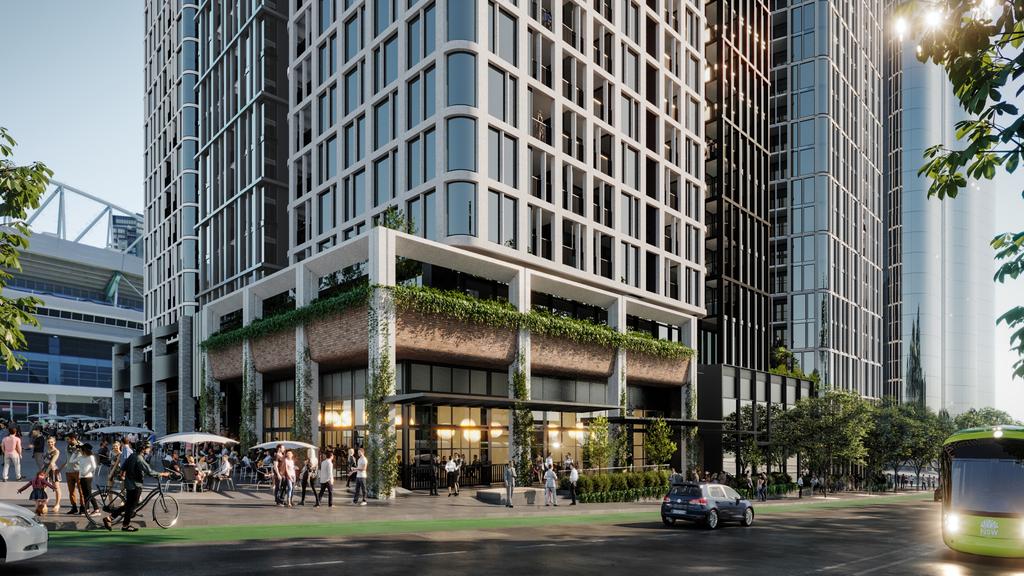Build-to-rent Home dream rises from the Grollo ashes

An artist’s impression of the new build-to-rent towers next to Marvel Stadium in Melbourne’s Docklands.
The Grollo name is set to live again on the nation’s skylines, but this time as silent partners in a build-to-rent empire, a world away from the concrete business started by family patriarch Luigi.
Home, built by Daniel Grollo in the background of the turmoil that engulfed the family’s legacy Grocon construction business, is set to power forward with six projects across Sydney and Melbourne and a portfolio of ready sites.
The build-to-rent business, set up by Mr Grollo and investment partners in 2018, has been building momentum and adding staff.
Home opened doors on the Coles shopping precinct of its major Richmond development in early March, with fit-out on the residences soon to wrap up and previews set for late March.
Mr Grollo has largely stepped away from the Home build-to-rent business, with former Grocon lieutenant Christian Grahame taking the reins.
Mr Grahame joined Grocon in late 2016 after 20 years at developer stablemate Mirvac, where he led its national apartments division.
In mid-2017 Mr Grahame joined the Home business, just as Grocon was preparing for its first foray into the space, as builder on the redevelopment of the Commonwealth Games Athletes village in Queensland, with a $500m project by investment manager UBS Asset Management.
“We were a pioneer in the Australian build-to-rent sector around four years ago,” Mr Grahame said.
However, Grocon’s first foray saw the builder burned, with cost blowouts.

Home’s Richmond development in Melbourne.
This was soon after followed by a court bust-up with developer Dexus and the tax office, a $28m fight which culminated in Grocon pulling the plug on several companies.
But the build-to-rent plans were not over, with documents from the wash-up of the Grocon administration showing $11.6m in loans flowing from the legacy construction business to three entities which were to provide services to the build-to-rent business.
By early 2021 the entire Grocon group of companies was in administration, as the construction business overseen by Mr Grollo collapsed, with creditors owed $104m.
Australian Property Group, which was recently acquired by Dexus, was particularly vocal in targeting Mr Grollo’s assets, arguing for administrators to attempt to make a claim on the millions funnelled into the entities that provided services to Home.
In addition Home was able to make itself at home in the Grocon offices on King Street.
But the Grocon scion came through with a plan to wipe the slate clean for the family business and its debts, with a deed of company arrangement which saw him contribute $13.2m.
This saw all loans to the companies providing services to the build-to-rent business wiped and the financial relationship between Home and the Grocon business severed, leaving Home to stand on its own.
Despite the headwinds that saw Grocon scuttled, Home is riding a demographic and financial wave that is set to transform swathes of the housing market.
Housing is becoming more expensive, while the Covid-19 pandemic has transformed workers’ preferences for where to live.

Head of Home Christian Grahame.

Daniel Grollo. Picture: Stuart McEvoy
Mr Grahame notes the Home brand is inspired by luxury hotels, aiming to bring the prestige and comfort of holidaying to homes – in comparison to the often complicated relationship many renters have with landlords, and a tendency for rentals to be under-maintained and tough to access.
“We’re aiming for a customer that is renting by choice and is seeking that combination of a security of tenure and lifestyle,” he notes.
“We do expect we will appeal to a segment of the older demographic trading out of larger homes or transitioning through later stages of life, perhaps they’ve moved from interstate or overseas.
“We expect the largest cohort will be young professionals seeking to be close to work.”
Home’s picks for sites show the developer’s read on the trends.
With three sites in Melbourne – Docklands, Southbank, and Richmond – plus early moves on a site in South Yarra’s Chapel Street, as revealed in The Australian’s Margin Call column, Home is looking through the Victorian capital’s pandemic lull for a city-centric future.
It’s a similar story in Sydney with projects in Parramatta, St Peters and St Leonards.

An artist’s impression of Home Southbank.
Mr Grahame said Home was “very careful” in the project design of its buildings.
“They’re locations we envisage where young white-collar professionals would find desirable to live,” he said. “As we look to continue to grow we will have an eye to new cities like Brisbane where we think there’s an option to appeal to young white-collar professionals.”
The secret to Home’s fast expansion has been financial backers and the promise of major money in the years ahead.
Mr Grahame said he wouldn’t discuss Home’s investors, but Singapore sovereign wealth player GIC is a well-known supporter.
GIC has deep pockets, with some estimates saying the colossus has as much as $US744bn invested worldwide. With 765 apartments for rent across Home Southbank and Richmond sites, as well as retail and office space for rent, the numbers adds up.
Home is targeting a $650 weekly rent on its Southbank one-bedroom apartments.
“By being both the developer and operator the integration of those two functions allows us to have input at all stages of the asset’s life,” Mr Grahame said.
While the impact of inflation was being felt across Home’s construction projects, it may have an upside in the rents the business could command on its projects, he said.
“We’re beginning to see analysts saying that there will be pressure on rents, particularly due to constrained supply,” he said. “I think an inflationary environment where wages are growing is good for rent growth. ”







